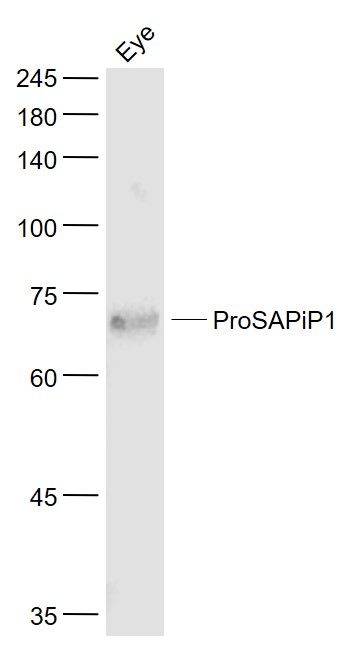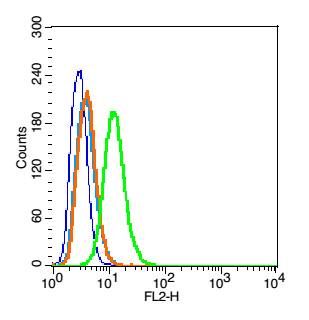ProSAPiP1 Polyclonal Antibody
Purified Rabbit Polyclonal Antibody (Pab)
- SPECIFICATION
- CITATIONS
- PROTOCOLS
- BACKGROUND

Application
| WB, IHC-P, IHC-F, IF, ICC, E |
|---|---|
| Primary Accession | O60299 |
| Reactivity | Rat, Pig, Dog, Bovine |
| Host | Rabbit |
| Clonality | Polyclonal |
| Calculated MW | 72 KDa |
| Physical State | Liquid |
| Immunogen | KLH conjugated synthetic peptide derived from human ProSAPiP1 |
| Epitope Specificity | 151-250/673 |
| Isotype | IgG |
| Purity | affinity purified by Protein A |
| Buffer | 0.01M TBS (pH7.4) with 1% BSA, 0.02% Proclin300 and 50% Glycerol. |
| SUBCELLULAR LOCATION | Cell junction > synapse > postsynaptic cell membrane > postsynaptic density. Cytoplasm > cytoskeleton. Detected at synapses, postsynaptic density, synaptic spines and dendrites. |
| SIMILARITY | Belongs to the PROSAPIP1 family. |
| SUBUNIT | Interacts (via C-terminus) with SHANK3 (via PDZ domain). Interacts (via coiled coil) with SIPA1L1. Can form homooligomers (By similarity). |
| Important Note | This product as supplied is intended for research use only, not for use in human, therapeutic or diagnostic applications. |
| Background Descriptions | The ProSAP family of proteins contain many protein-protein interaction domains and serve as scaffolding mediators within the post-synaptic density (PSD) of excitatory brain synapses. The PSD is an electron-dense structure underneath the post-synaptic plasma membrane of excitatory synapses that anchors and clusters glutamate receptors opposite to the pre-synaptic neurotransmitter release site. Shank proteins contain PDZ modular domains that coordinate the synaptic localization of ion channels, receptors, signaling enzymes, and cell adhesion molecules. The PDZ domain mediates protein-protein interactions via the recognition of a conserved sequence motif at the C-terminus of their target protein(s). ProSAPiP1 (proline rich synapse associated protein interacting protein 1) is a 673 amino acid protein that interacts with the PDZ domain of Shank 3. ProSAPiP1 expression is brain-specific with highest expression within the cerebellum, hippocampus and cerebral cortex. |
| Gene ID | 9762 |
|---|---|
| Other Names | Leucine zipper putative tumor suppressor 3, ProSAP-interacting protein 1, LZTS3 (HGNC:30139) |
| Dilution | WB=1:500-2000,IHC-P=1:100-500,IHC-F=1:100-500,ICC=1:100-500,IF=1:100-500,Flow-Cyt=1 µg/Test,ELISA=1:5000-10000 |
| Format | 0.01M TBS(pH7.4), 0.09% (W/V) sodium azide and 50% Glyce |
| Storage | Store at -20 ℃ for one year. Avoid repeated freeze/thaw cycles. When reconstituted in sterile pH 7.4 0.01M PBS or diluent of antibody the antibody is stable for at least two weeks at 2-4 ℃. |
| Name | LZTS3 (HGNC:30139) |
|---|---|
| Function | May be involved in promoting the maturation of dendritic spines, probably via regulating SIPA1L1 levels at the postsynaptic density of synapses. |
| Cellular Location | Synapse {ECO:0000250|UniProtKB:Q8K1Q4}. Postsynaptic density {ECO:0000250|UniProtKB:Q8K1Q4}. Cell projection, dendritic spine {ECO:0000250|UniProtKB:Q8K1Q4}. Cell projection, dendrite {ECO:0000250|UniProtKB:Q8K1Q4}. Cytoplasm, cytoskeleton {ECO:0000250|UniProtKB:Q8K1Q4}. Note=Rather found at excitatory than inhibitory synapses. {ECO:0000250|UniProtKB:Q8K1Q4} |

Thousands of laboratories across the world have published research that depended on the performance of antibodies from Abcepta to advance their research. Check out links to articles that cite our products in major peer-reviewed journals, organized by research category.
info@abcepta.com, and receive a free "I Love Antibodies" mug.
Provided below are standard protocols that you may find useful for product applications.
If you have used an Abcepta product and would like to share how it has performed, please click on the "Submit Review" button and provide the requested information. Our staff will examine and post your review and contact you if needed.
If you have any additional inquiries please email technical services at tech@abcepta.com.













 Foundational characteristics of cancer include proliferation, angiogenesis, migration, evasion of apoptosis, and cellular immortality. Find key markers for these cellular processes and antibodies to detect them.
Foundational characteristics of cancer include proliferation, angiogenesis, migration, evasion of apoptosis, and cellular immortality. Find key markers for these cellular processes and antibodies to detect them. The SUMOplot™ Analysis Program predicts and scores sumoylation sites in your protein. SUMOylation is a post-translational modification involved in various cellular processes, such as nuclear-cytosolic transport, transcriptional regulation, apoptosis, protein stability, response to stress, and progression through the cell cycle.
The SUMOplot™ Analysis Program predicts and scores sumoylation sites in your protein. SUMOylation is a post-translational modification involved in various cellular processes, such as nuclear-cytosolic transport, transcriptional regulation, apoptosis, protein stability, response to stress, and progression through the cell cycle. The Autophagy Receptor Motif Plotter predicts and scores autophagy receptor binding sites in your protein. Identifying proteins connected to this pathway is critical to understanding the role of autophagy in physiological as well as pathological processes such as development, differentiation, neurodegenerative diseases, stress, infection, and cancer.
The Autophagy Receptor Motif Plotter predicts and scores autophagy receptor binding sites in your protein. Identifying proteins connected to this pathway is critical to understanding the role of autophagy in physiological as well as pathological processes such as development, differentiation, neurodegenerative diseases, stress, infection, and cancer.



